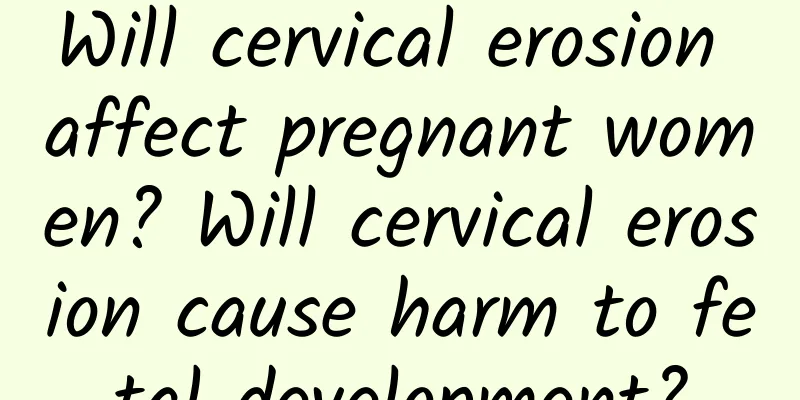Will cervical erosion affect pregnant women? Will cervical erosion cause harm to fetal development?

|
Will cervical erosion affect pregnant women? Cervical erosion is actually a misunderstanding of a normal cervical manifestation in the past. Now it is replaced by the physiological phenomenon of "cervical columnar epithelium ectopia" in academia. Will it cause harm to fetal development? Let's learn about it next. What is cervical erosion? There are two different types of cells in the cervix, the ones near the vagina are squamous cells, and the ones near the uterus are columnar cells. The two types of epithelial cells are different in appearance. The central part, which looks a bit like "eroded" cervix, is the appearance after being covered by columnar epithelium, while the relatively smooth outer part of the cervix is the part of the cervix covered by squamous epithelial cells. Before puberty, women's ovarian function is not perfect, estrogen is low, and the columnar epithelium is closer to the inside. After menstruation, the columnar epithelium is affected by estrogen and develops more to the outside. Therefore, more columnar epithelium similar to "erosion" is found during cervical examination. After menopause, women's estrogen levels drop, and the columnar epithelium begins to retreat to the inside. At this time, the "erosion" is no longer visible during examination. Therefore, in essence, the so-called cervical erosion is actually the eversion of the columnar epithelium. Does cervical erosion affect fertility? Understanding that cervical erosion is a physiological phenomenon means that it will not affect fertility. Does cervical erosion need regular check-ups? Regular cervical examination is necessary, not to prevent cervical erosion, but to prevent cervical cancer. How to treat cervical erosion Cervical columnar epithelial ectopia does not require any treatment. Many current methods for treating cervical erosion are wrong. However, symptomatic cervicitis does need to be treated. Acute inflammation is treated with suppositories, and chronic inflammation can be treated with physical therapy such as laser or freezing. Will cervical erosion develop into cancer if it is not treated? The occurrence of cervical cancer is related to infection with human papillomavirus (HpV). Some so-called high-risk types of HPV are prone to precancerous lesions and cervical cancer when they continue to infect the squamous-columnar junction of the cervix. Since the advent of cervical smears, the mortality rate of cervical cancer has dropped significantly. The key is early prevention and treatment. It is currently recommended that women over the age of 21 should undergo a cervical smear examination once a year. After the age of 30, an HPV examination can be combined. If the HPV and cervical smear tests are negative for three consecutive times, the interval can be extended to once every three years, and screening can be stopped after the age of 65. |
Recommend
How to use medicine for bacterial vaginosis
Bacterial vaginosis is a disease caused by an inc...
What are the early symptoms of ectopic pregnancy?
What are the early symptoms of ectopic pregnancy?...
How does habitual miscarriage occur? Knowing it early will benefit you sooner
Habitual miscarriage is indeed very disturbing fo...
What is the most effective way to treat moderate cervical erosion? The best treatment for moderate cervical erosion in women
Many women are troubled by gynecological diseases...
Do you know the signs of ectopic pregnancy?
What are the signs of ectopic pregnancy? Do you k...
What medicine can eliminate uterine cysts?
Treatment of uterine cysts usually requires medic...
How to effectively prevent vaginitis
Vaginitis is one of the common gynecological infl...
3 cold-weather stretching tips for runners to keep their knees below the ground
Although the weather is freezing, Chinese people’...
How to relieve the pain in my stomach during my period
Abdominal pain during menstruation may be a norma...
What should I do if I have multiple uterine fibroids?
Multiple uterine fibroids are the most common ben...
Is the uterine fluid discharge blood?
Uterine effusion is not necessarily blood, but it...
What should patients with vaginitis pay attention to in daily life?
What should patients with vaginitis pay attention...
Experts tell you the advantages of painless abortion
Painless abortion is a common abortion procedure ...
There is a consensus! Junk food promotion to children will be banned
High-salt, high-calorie foods are nicknamed "...
What are the symptoms of cervical erosion?
Cervical erosion is a common gynecological diseas...




![[Video version] This exercise is essential to increase immunity during the epidemic!](/upload/images/67dcf8e833ca2.webp)




